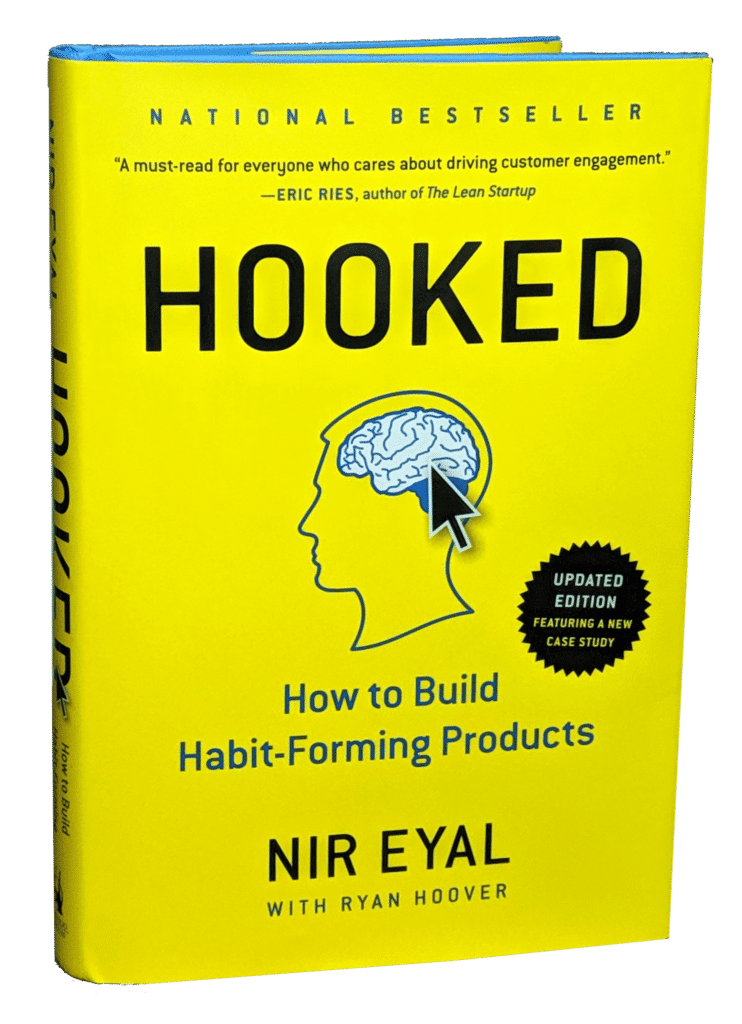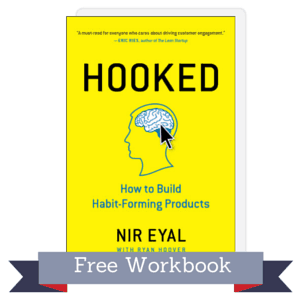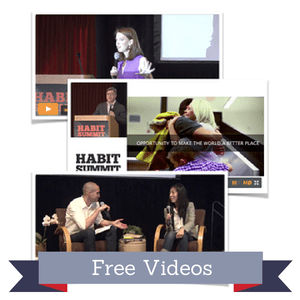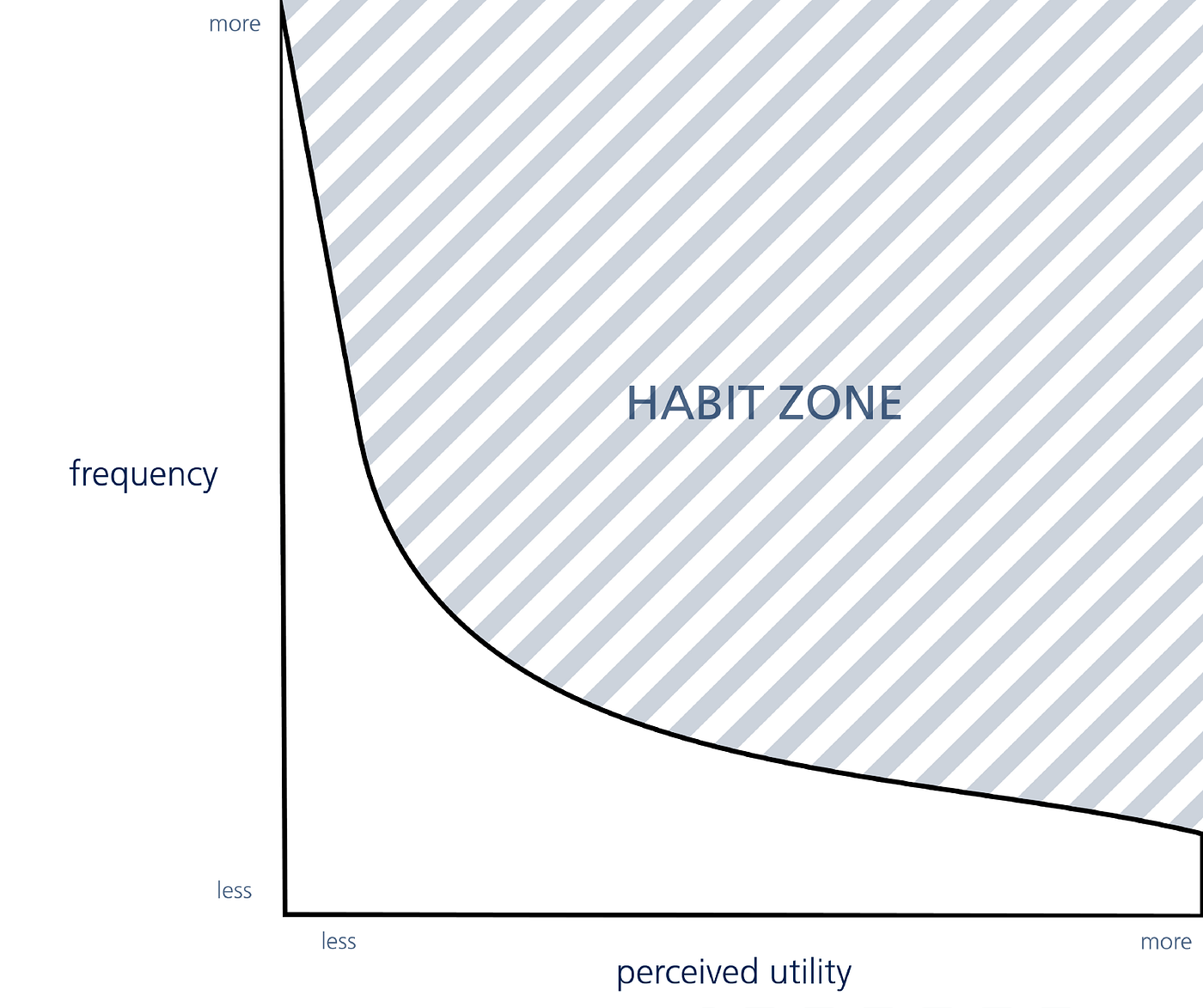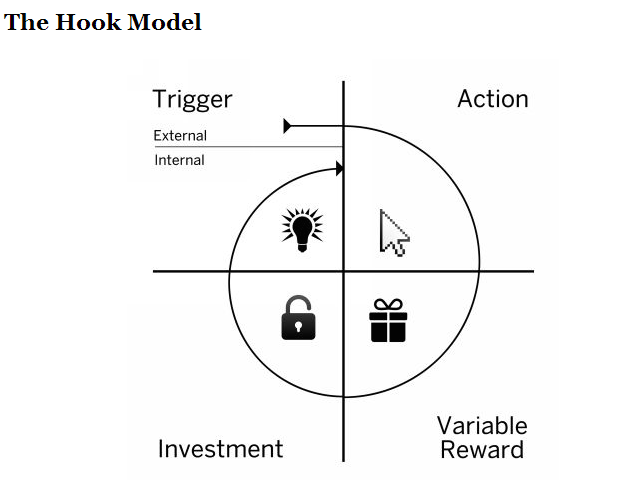Hooked how to build habit forming products
Hooked how to build habit forming products
Руководство по созданию продуктов, формирующих привычки. Часть первая
Данная серия статей представляет собой описание «Модели крюка» (Hook model) из книги «Hooked: How to Build Habit-Forming Products» автора Nir Eyal.
Введение
Технологии, которые мы используем, делают нас зависимыми. Сколько раз, открыв «на минуту» Youtube, Facebook или Twitter вы ловили себя за этим же занятием через час?
Когнитивная психология определяет привычку как автоматическое поведение, возникающее в определенной ситуации.
Продукты и сервисы, которые мы используем по привычке, меняют наше поведение согласно намерениям их дизайнеров. Что же делает некоторые продукты такими «привычко-образующими»?
Описание модели
Исследования автора привели к созданию модели Крюка (Hook model): 4-х фазного процесса, который используют компании для формирования пользовательских привычек.
Триггер (Trigger)
Триггеры делятся на два вида: внешние и внутренние.
Технологии, которые меняют привычки, начинают изменять поведение пользователя с помощью внешних триггеров, которые содержат в себе призыв к действию (call to action).
4 типа внешних триггеров
1. Платные
Реклама, настройка места в поисковой выдаче и прочие платные каналы обычно используются, чтобы привлечь внимание пользователя и заставить его совершить действие. Обычно используются только на начальных этапах работы с пользователем.
2. Заслуженные
Положительные упоминания в СМИ, виральные ролики на Youtube, выделенные места в магазинах приложений (например, блок Выбор редакции в AppStore) — места, за которые обычно не платятся деньги (или не платятся напрямую), но позволяющие привлечь внимание пользователя.
3. «Сарафанное радио»
Когда пользователи продукта рассказывают о нем своим знакомым путем личного общение, отправляя ссылку на Facebook или через электронную почту — это может стать крайне эффективным внешним триггером для действия.
4. Реальные
Триггеры, которые пользователь сам размещает в своем окружении. Иконка приложения, email-рассылка, на которую подписан пользователь, оповещение об обновлении приложения возникают только в том случае, если пользователь соглашается их получать.
Однако внешние триггеры являются только первым шагом. Основная их цель — вовлечь пользователя в «Модель крюка», чтобы со временем у него отпала потребность во внешних триггерах и одновременно сформировались внутренние триггеры.
Внутренние триггеры
К ним относятся эмоции, особенно негативные. Чувства скуки, одиночества, разочарования, нерешительности вызывают легкую боль или раздражение и вызывают практически мгновенное и часто неосозноваемое действие для снятия негативного ощущения. Например, открытие Youtube от скуки или Twitter от одиночества.
Положительные эмоции также могут служить в качестве внутренних триггеров. Например, желание поделиться хорошими новостями приводит пользователя в Facebook.
В случае с внутренними триггерами информация о том, что делать дальше, содержится в памяти пользователя.
Ассоциация между определенным продуктом и внутренним триггером может формироваться неделями и месяцами регулярного использования.
Важнейшая цель продуктов, формирующих привычки — решить проблему пользователя таким образом, чтобы у него сформировалась четкая ассоциация между продуктом и решением проблемы.
Hooked: How to Build
Habit-Forming Products
National Bestseller
Hooked: How to Build
Habit-Forming Products
Revised and Updated, Featuring a New Case Study
“A must read for everyone who cares about driving customer engagement.”
-Eric Ries, author, The Lean Startup
Order Hooked »
Nir Eyal’s writing has been featured in
Hooked gives you the blueprint for the next generation of products. Read Hooked or the company that replaces you will.
The book everyone in Silicon Valley is talking about.
When it comes to driving engagement and building habits, Hooked is an excellent guide into the mind of the user.
Technology Writer & Investor
Claim Your Exclusive Hooked Bonuses
Order the updated edition of Hooked and claim your exclusive bonuses.
Hooked Supplemental Workbook
This workbook is the perfect complement to Hooked. It is specially designed to help you build your own habit-forming product or service.
Product Psychology
Course
We’ve asked the brightest minds in the field to share their best resources on user behavior with our members.
Behavioral Design
Videos
Hear from bestselling author Gretchen Rubin on “The Secret to Making and Breaking Habits,” industry veteran Josh Elman on “How Twitter Built User Habits”, and more!
CLAIM YOUR HOOKED EXCLUSIVE BONUSES
GET PRE-ORDER BONUSES
Once you’ve ordered your updated edition of Hooked, enter your name, email address, and purchase details below to get access to the free Hooked bonus materials.
Order your updated edition of Hooked,
featuring a new case study.
Order Hooked »
How do successful companies
create products people love to use?
Why do some products capture widespread attention while others flop? What makes us engage with certain products out of sheer habit? Is there a pattern underlying how technologies hook us?
Nir Eyal answers these questions (and many more) by explaining the Hook Model—a four-step process embedded into the products of many successful companies to subtly encourage customer behavior. Through consecutive “hook cycles,” these products reach their ultimate goal of bringing users back again and again without depending on costly advertising or aggressive messaging.
Hooked is based on Eyal’s years of research, consulting, and practical experience. He wrote the book he wished had been available to him as a start-up founder—not abstract theory, but a how-to guide for building better products. Hooked is written for product managers, designers, marketers, start-up founders, and anyone who seeks to understand how products influence our behavior.
Eyal provides readers with:
I speak about product management all over the world, and this is the single book I consistently recommend as a must-read.
The most high bandwidth, high octane, and valuable presentation I have ever seen on this subject.
Hooked is the definitive guide to customer engagement and retention in the digital age.
Habit is a frequent behaviour displayed with little or no conscious thought. Habits die hard, and the ones which enrich our lives can be used for good.
Study shows that frequency of a new behaviour is leading factor in forming a new habit. The second most important factor is Change in attitude about the behaviour. This change in attitude can be defined as rise in perceived utility of the behaviour. Once there is enough frequency and perceived utility, new behaviour will enter the habit forming zone.
Hook is a model, an experience designed to connect the user’s problem with the solution (the product), essentially with enough frequency to form a habit.
The Hook model is the juice of author’s experience, observation and readings working with hundreds of companies worldwide, in a quest of knowing what’s common among winners and what was missing from the losers.
Triggers
It’s a cue for behaviour. It’s like spark plug in the engine, which ignites the function. Triggers are of two types; 1. External & 2. Internal triggers.
External Triggers — External Triggers are first steps towards changing user’s behavior. Habit forming technologies start changing behaviour by first cueing users with a call to action and are generally loaded with information about the next action user should take. However, external triggers can also convey this information implicitly, like, we all know, web links are to be clicked. External triggers are of following types; 1. Paid, 2. Earned, 3. Relationship & 4. Owned.
Paid Triggers — These are paid channels commonly used to get user’s attention. These can be effective but costly to keep users coming back. Thus, it is not advised to rely upon paid triggers for very long, if at all. Examples of paid channels are advertising and search engine marketing etc.
Earned Triggers — These triggers require companies to keep their product in limelight, a difficult and unpredictable task. It requires investment in form of public & media relation, favorable press mentions, viral content and/or favorable app store placement.
Relationship Triggers — These triggers depend on user’s relations with one another. These are like old fashioned word of mouth, a social media invite, like or share etc., where one person telling/appreciating about the product to another can be highly effective. Relationship triggers can give viral hyper growth, entrepreneurs and investors lust after. Sometime this trigger drive growth because people love to share about a good offer.
Owned Triggers — These require a space in user’s environment, with their permission. As long as a user agrees to receive the trigger, the company that sets the trigger owns a share of user’s attention. Where other external trigger drives new user acquisition, owned triggers prompt repeat user engagement. Without this trigger, it is difficult to cue users frequently enough to change their behavior. An email newsletter to which user subscribes and an app notification etc. are examples of Owned triggers.
Internal Triggers — Internal Triggers are at play when need to explicitly cue user on what to do next diminishes or vanishes. Internal triggers are intangible and manifest automatically in user’s mind. With frequent repetition of new behavior, information on what to do next gets coupled with user’s emotion and need for external trigger is replaced by internal ones. Hence, when a product, that provides an effective solution to our problem, becomes tightly coupled with a thought, an emotion, or a preexisting routine, it leverages an internal trigger. Negative emotions are generally powerful internal triggers, like Fear Of Missing Out (FOMO), fear of losing a moment, and indecisiveness etc. One classic example of internal trigger at play can be seen in our behavior, when we sought to google search, without giving much conscious thought.
Building for Trigger — The ultimate goal of a habit forming product is to solve the user’s pain by creating an association so that user identifies the product as a source of relief. To be able to do so, product designer needs to understand the pain he/she trying to kill in terms of emotions. What would a user be thinking right before he is relieved of this pain, for example, FOMO, in case Instagram users. What would user want to achieve by using your solution. When & where will they use it. What emotions influence their use and will trigger them to action.
To achieve so, Jack Dorsey, co-founder of Twitter, describes how he truly tries to understand his users by writing user narratives. He tries to write the detailed narrative of situation his user is in. It reads like a play. If you do that story well all of the priorities, product, design and coordination that you need to do with this product fall out naturally. Ultimately, you are required to know your user very well. Author suggests asking question “Why” as many times as it takes to get to an emotion. Usually it happens by fifth why.
ACTION
Action is the simplest behaviour in the anticipation of reward. Fogg’s behaviour model is represented in the formula B=MAT, where behaviour will occur when motivation, ability & trigger are present at same time in sufficient degree. If any element of this equation is missing, behaviour will not occur. We have already covered trigger, let us now understand motivation & ability.
Motivation — It is the level of desire or energy for action. Fogg defines three core motivators that impact level of desire and states that all humans are motivated by these.
1. to seek pleasure or avoid pain
2. to seek hope or avoid fear
3. to seek social acceptance or avoid rejection
The two sides of three motivators can be seen as levers to adjust the level of motivation.
Ability — It is the capacity to do a particular action. Any technology or product that significantly reduce/simplify the number of steps required to perform an action, enjoys higher adoption rate. To successfully simplify a product, we must remove obstacles that stand in user’s way. Fogg defines six elements of simplicity.
3. Physical effort
4. Brain cycles (mental effort)
5. Social deviance (acceptance)
6. Non-routine (how much existing routine changes)
Level of these factors can increase or decrease the ability to perform an action. For example; home page of Google search vs Yahoo search, where Google has very clean search page devoid of any ads and with big search button, yahoo’s page is cluttered with ads.
Heuristics and Perception
Heuristics are the mental shortcuts we take to make decision and form opinion. These serve as exceptions to Fogg’s equation of human behaviour, B=MAT. The author has discussed four of these brain biases.
The Scarcity Effect — It means that customer value a product more if availability is scarce. If a product starts off as scarce and becomes abundant, it loses value. For Example; Limited quantity listed online makes customer believe that product is scarce and motivate them to purchase asap. The mobiles phones sold in flash sale, loses value as soon as they are available abundantly.
The Framing Effect — It shows that perception of the user is also derived by how the product is framed, even when there is little to no relationship with reality. For example, same product packaged and priced differently will have different effect of derived value.
The Anchoring Effect — It shows people often anchor to only one piece of information. For Example, Same product in a buy one get one offer generally sells faster than selling items individually, even if individual item is costing less to customer.
The Endowed Progress Effect — It is a phenomenon that increases motivation as people believe they are nearing goal. For example, In a study two similar groups of customers were given punch cards. When the card was fully punched they were to receive a gift. One group was given a non-punched card and required 8 punches to receive the gift, while other group was given a card with 10 punch spaces, with 2 spaces already punched in and also required 8 punches to receive the gift. At the end of study second group had 82% higher completion rate, which was associated with 2 punches provided with the card, giving endowed progress effect.
VARIABLE REWARD
It is the unpredictable reward you provide to users for completing an action. What distinguishes the Hook Model from a plain vanilla feedback loop is the hook’s ability to create a craving. Feedback loops are all around us, but predictable ones don’t create desire. Studies revealed that what draws users more to act, is the sensation to receive the reward rather than sensation of receiving the reward itself. The stress of desire seems to compel us more. Author categorizes the rewards in three types.
Rewards of the Tribe — These are the rewards that we receive from our social connections. Our brain is adapted to seek rewards that make us feel accepted, attracted, important and included. These rewards keeps us coming back and wanting more. For Example, Likes & shares of ones post on Facebook.
Rewards of the self — These are the rewards we seek for a more personal gratification. We are driven to conquer obstacles, even if just for the satisfaction of doing so. Pursuing a task to completion can influence all sorts of behaviors. For example, watching someone investing countless hours into completing a tabletop puzzle can reveal frustration, even when they actually do not receive any prize, other than the satisfaction of completing it.
Important considerations for designing a reward system
Variable rewards are not a free pass — Only by understanding what truly matters to users can a company correctly match the right variable reward to their intended behavior. Elements like monetary rewards and gamification (creating game-like environment) etc. will not result in desired behavior, unless, that is what user truly wants. A variable reward must satisfy users’ needs while leaving them wanting for more (re-engagement with the product). For Example Mahalo.com’s monetary rewards could not result in repeat engagement whereas Quora’s plain & simple Q&A worked, where users could up-vote an answer they liked.
Maintain a sense of Autonomy — Companies that successfully change behaviors present users with an implicit choice between their old way of doing things and a new way, a more convenient way to fulfil existing needs. By maintaining the users’ freedom to choose, products can facilitate adoption of new habits and change behavior for good. In a study, adding “But you are free” statement turned out to have really positive result to a persuasion effort. Habit forming businesses should beware of losing users’ autonomy, it can result in rebellious behavior called “reactance”.
Beware of finite Variability — Companies that successfully want to change behaviors for long term should keep the reward variable and understand user’s insatiable desire for novelty. Experiences with finite variability become less engaging because they eventually become predictable. For example, Farmville or all single player game suffer from finite variability. Once you know, what’s next it becomes boring.
Platforms like YouTube, Facebook, Pinterest and twitter leverages user-generated content to provide visitors with a never ending stream of newness, but naturally even these are not guaranteed to hold on to users forever. Hence products utilizing infinite/longer variability stand a better chance of holding user attention.
INVESTMENT
This phase is the point where user is asked to do a bit of work. Here users are prompted to put something of value, like, time, details(profile), social connections or money etc., into the system, which increase the likelihood of their using the product and successive passes through the hook cycle. Unlike action phase of hook cycle, investments are about anticipation of long term rewards. Investment comes after the variable reward phase, when users are primed to reciprocate.
For example, In Twitter, following someone is an investment, which does not provide any immediate reward, but increase the likelihood of user using Twitter again. Below are the tendencies that influence our future actions. These tendencies of ours lead to a mental process known as rationalization, in which we change our attitude and behavior to adapt psychologically.
We irrationally value our Efforts — Business that leverages user efforts confer higher value in their products simply because their users have put work into them. These users have invested in the products through their labor and thus fall in love with the product. This is also known as IKEA effect.
We seek to be consistent with our past behaviors — Study has revealed that our future actions are greatly consistent with our part actions. Tiny investments in the product today can change user’s behavior favorably in the future in a big way.
We avoid cognitive dissonance — To avoid the cognitive dissonance of not liking something that others seem to take so much pleasure in, we slowly change our perception of the thing we once did not enjoy.
FINALLY
For a user to build habit of using the product/service, user must first use the product through multiple cycles of Hook model. Therefore, external triggers must be used to bring back user around again to start another cycle. Habit forming technologies leverage the user’s past behavior to initiate an external trigger in the future.
FURTHER
Do you think a maker of product can misuse the power of manipulating user’s habits?
When do you think it is right and when it is not?
How do you recognize habit forming opportunities?
Nir Eyal and Ryan Hoover has provided some guidelines for makers to answer above questions, I will cover these in my next blog!!
Hooked — How Companies Create Habit Forming Products
How do companies create habit-forming products? It’s simple: They manufacture them.
In 2008 Nir Eyal was part of a team of Stanford MBAs starting a company backed by “some of the brightest investors in Silicon Valley.” They wanted to build a platform to place ads into online social games. Eyal wondered how mind manipulation worked — how do products change our actions, and create compulsions. How do you engineer user behavior? Are there moral implications? Could these forces be used for good (nudging). So he looked around for a guide. He couldn’t find anything that satisfied him so he documented his experiences, reading, and observations of hundreds of companies “to uncover patterns in user experience designs and functionality.” He wanted to know what was common between the “winners” and determine what was missing from the “losers.”
The result of this effort is his book Hooked: How to Build Habit-Forming Products and the creation of the Hook Model: a four-phase process that companies use to form habits.
Through consecutive hook cycles, successful products reach their ultimate goal of unprompted user engagement, bringing users back repeatedly, without depending on costly advertising or aggressive messaging.
That sounds like a growth hacker’s dream.
Let’s take a look.
1. Trigger
A trigger is the actuator of behavior — the spark plug in the engine. Triggers come in two types: external and internal. Habit-forming products start by alerting users with external triggers like an email, a website link, or the app icon on a phone.
For example, suppose Barbra, a young woman in Pennsylvania, happens to see a photo in her Facebook newsfeed taken by a family member from a rural part of the state. It’s a lovely picture and since she is planning a trip there with her brother Johnny, the external trigger’s call-to-action intrigues her and she clicks. By cycling through successive hooks, users begin to form associations with internal triggers, which attach to existing behaviors and emotions.
When users start to automatically cue their next behavior, the new habit becomes part of their everyday routine. Over time, Barbra associates Facebook with her need for social connection.
2. Action
Following the trigger comes the action: the behavior done in anticipation of a reward. The simple action of clicking on the interesting picture in her newsfeed takes Barbra to a website called Pinterest, a “pinboard-style photo-sharing” site.
This phase of the hook, as described in chapter three, draws upon the art and science of usability design to reveal how products drive specific user actions. Companies leverage two basic pulleys of human behavior to increase the likelihood of an action occurring: the ease of performing an action and the psychological motivation to do it.
Once Barbra completes the simple action of clicking on the photo, she is dazzled by what she sees next.
3. Variable Reward
What distinguishes the Hook Model from a plain vanilla feedback loop is the hook’s ability to create a craving. Feedback loops are all around us, but predictable ones don’t create desire. The unsurprising response of your fridge light turning on when you open the door doesn’t drive you to keep opening it again and again. However, add some variability to the mix — say a different treat magically appears in your fridge every time you open it — and voila, intrigue is created.
Variable rewards are one of the most powerful tools companies implement to hook users; chapter four explains them in further detail. Research shows that levels of the neurotransmitter dopamine surge when the brain is expecting a reward. Introducing variability multiplies the effect, creating a focused state, which suppresses the areas of the brain associated with judgment and reason while activating the parts associated with wanting and desire. Although classic examples include slot machines and lotteries, variable rewards are prevalent in many other habit-forming products.
When Barbra lands on Pinterest, not only does she see the image she intended to find, but she is also served a multitude of other glittering objects. The images are related to what she is generally interested in — namely things to see on her upcoming trip to rural Pennsylvania — but there are other things that catch her eye as well. The exciting juxtaposition of relevant and irrelevant, tantalizing and plain, beautiful and common, sets her brain’s dopamine system aflutter with the promise of reward. Now she’s spending more time on Pinterest, hunting for the next wonderful thing to find. Before she knows it, she’s spent 45 minutes scrolling.
4. Investment
The last phase of the Hook Model is where the user does a bit of work. The investment phase increases the odds that the user will make another pass through the hook cycle in the future. The investment occurs when the user puts something into the product or service such as time, data, effort, social capital, or money.
As Barbra enjoys endlessly scrolling through the Pinterest cornucopia, she builds a desire to keep the things that delight her. By collecting items, she’ll be giving the site data about her preferences. Soon she will follow, pin, re-pin, and make other investments, which serve to increase her ties to the site and prime her for future loops through the hook.
Hooked: How to Build Habit-Forming Products goes on to explore external and internal triggers, why some people eventually lose their taste for certain experiences, the impact of variability on retention, and how investments encourage users to cycle through successive hooks.
Hooked how to build habit forming products
Нир Эяль, Райан Хувер
Покупатель на крючке. Руководство по созданию продуктов, формирующих привычки
Hooked
How to Build Habit-Forming Products
Издано с разрешения литературного агентства Andrew Nurnberg
© Перевод на русский язык, издание на русском языке, оформление. ООО «Манн, Иванов и Фербер», 2014
Все права защищены. Никакая часть электронной версии этой книги не может быть воспроизведена в какой бы то ни было форме и какими бы то ни было средствами, включая размещение в сети Интернет и в корпоративных сетях, для частного и публичного использования без письменного разрешения владельца авторских прав.
Правовую поддержку издательства обеспечивает юридическая фирма «Вегас-Лекс»
© Электронная версия книги подготовлена компанией ЛитРес (www.litres.ru)
Эту книгу хорошо дополняют:
Увлекательное путешествие в мозг современного потребителя
Как маркетологи манипулируют нами и убеждают покупать их товары
Как превратить читателя в покупателя
Давайте посмотрим правде в глаза – мы на крючке.
Технологии, которые мы применяем, вызывают у нас иррациональную тягу к их использованию, а лучше сказать – полноценную зависимость. Это и желание проверить сообщение сразу после сигнала о его появлении, и стремление зайти в YouTube, Facebook или Twitter всего на несколько минут, а очнуться через час, продолжая при этом кликать и скроллить. Вы наверняка все это испытываете, хотя не всегда осознаете.
Как компании, производящие лишь строчки кода, который отображается на экране, умудряются контролировать умы пользователей? Что делает некоторые продукты вызывающими такую сильную зависимость?
Для многих продуктов формирование привычки – залог выживания. Поскольку за наше внимание конкурирует бесконечное количество отвлекающих факторов, компании-производители учатся доводить до совершенства методы, позволяющие им оставаться актуальными в глазах пользователей. Сегодня недостаточно привлечь миллионы клиентов. Компании все чаще замечают, что их стоимость на бирже напрямую зависит от силы привычки, которую они создают. Борясь за лояльность потребителей, мечтая о продукте, который они будут использовать регулярно, нужно научиться не только привлекать, но и приручать пользователей.
Одни компании только начинают осознавать эту новую реальность, а другие уже зарабатывают на ней. Мы поговорим о тех, кто, совершенствуя свои вызывающие привыкание продукты, делает их незаменимыми.
Выигрывает тот, чье название первым приходит в голову
Помимо прибыли компании, сформировавшие у клиентов устойчивые привычки, получают дополнительные преимущества. Они привязывают свои продукты к «внутренним триггерам». В результате пользователи обращаются к ним по своей воле, без внешнего воздействия.
“IDC-Facebook Always Connected.pdf – File Shared from Box.” По состоянию на декабрь 19, 2013. https://fb-public.app.box.com/s/3iq5x6uwnqtq7ki4q8wk.
Здесь и далее примечания, не заключённые в фигурные скобки, относятся к примечаниям автора.
Oulasvirta, Antti, Tye Rattenbury, Lingyi Ma, and Eeva Raita. “Habits Make Smartphone Use More Pervasive.” Personal Ubiquitous Comput. 16, no. 1 (январь 2012 г.): 105–114. doi:10.1007/s00779-011-0412-2.
Belic, Dusan, IntoMobile Thursday, February 9th, and 2012 at 12:50 AM. “Tomi Ahonen: Average Users Looks at Their Phone 150 Times a Day!” IntoMobile. По состоянию на 19 декабря 2013 г. http://www.intomobile.com/2012/02/09/tomi-ahonen-average-users-looks-their-phone-150-times-day/.
Morsella E, Bargh JA, Gollwitzer PM (eds) (2008) Oxford handbook of human action. Oxford University Press, Oxford.
Для этой книги я использовал определение формирования привычки в процессе обучения новым действиям за счет их повторения, до тех пор пока они не станут автоматическими. Я благодарю доктора Стивена Уэнделла за то, что он указал на существование целого спектра привычек. Описание других примеров автоматического поведения можно найти здесь: Bargh, John A. “The Four Horsemen of Automaticity: Awareness, Intention, Efficiency, and Control in Social Cognition.” In Handbook of Social Cognition, Vol. 1: Basic Processes; Vol. 2: Applications (2nd Ed.), edited by R. S. Wyer and T. K. Srull, 1–40. Hillsdale, NJ, England: Lawrence Erlbaum Associates, Inc, 1994.
Verplanken, Bas, and Wendy Wood. “Interventions to Break and Create Consumer Habits.” Journal of Public Policy & Marketing 25, no. 1 (март 2006 г.): 90–103. doi:10.1509/jppm.25.1.90.

